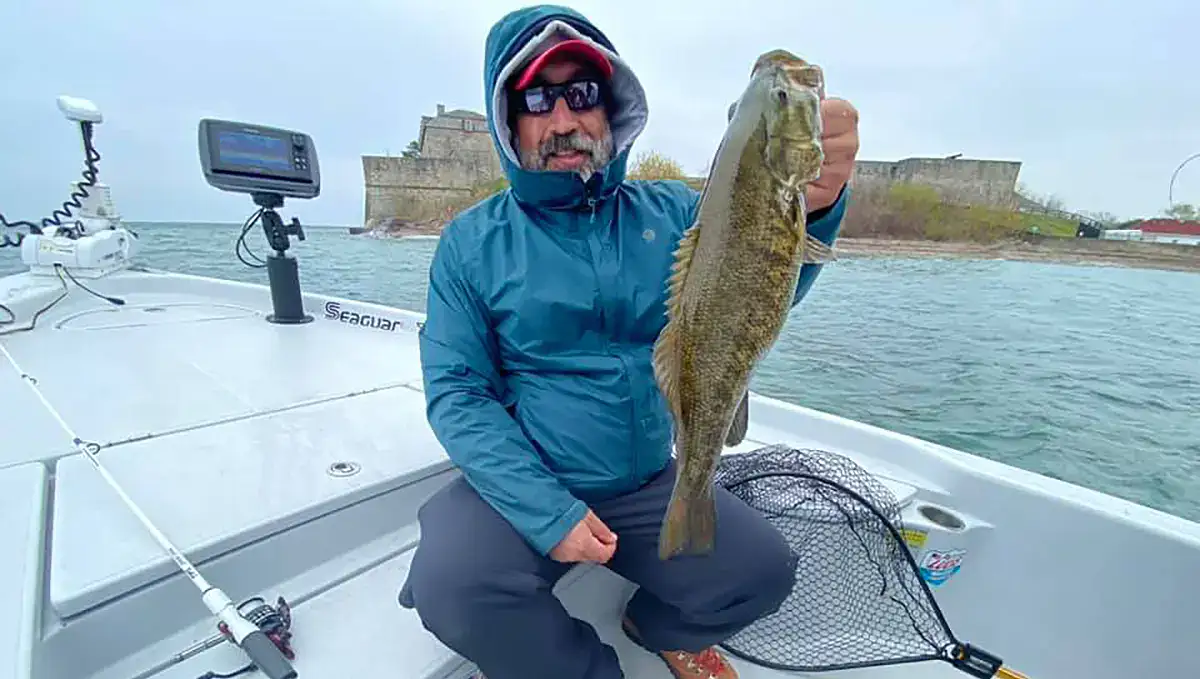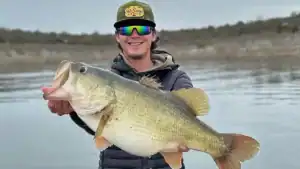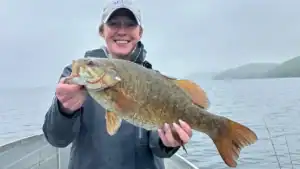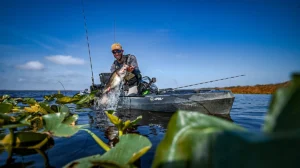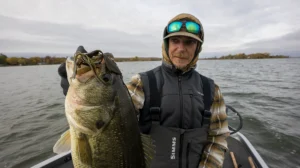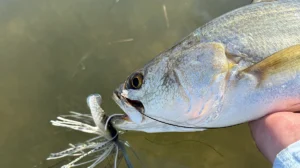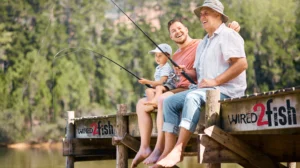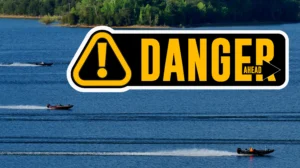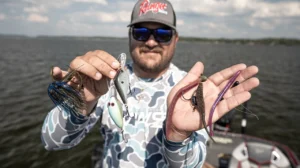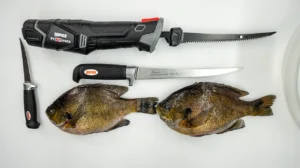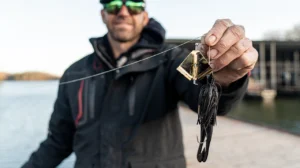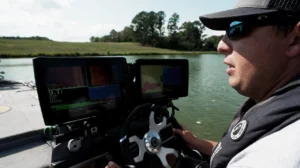The instant the fish hit, I knew it wasn’t a bass. The fight in the stiff current was steady but lacked that classic smallmouth punch. As the fish rose and its snout and dorsal fin broke the surface, the mystery was solved: it was a walleye.
We hadn’t set out to chase walleyes that morning, but the Niagara River has a way of surprising you. You really never know what you’re going to find, with lake trout, salmon, monster brown trout and even muskellunge. And you can catch them almost any way you want: casting, jigging, trolling, there’s almost no wrong technique. But for me, it’s the big, bronze-backed brutes that make every day on the water unforgettable.
I made my first trip up to the mighty Niagara many years ago. Before this trip, I’d only landed two smallies over five pounds in my life. In less than a week, I caught five more and lost another at the boat that guide Jeff Draper confidently called a 6-pounder. I’ve been hooked on the region ever since, and go out of my way to get up to the Lewiston area whenever possible.
The Niagara River isn’t just a natural wonder; it’s one of North America’s most legendary fisheries. Flowing between Lake Erie and Lake Ontario, this powerful waterway is best known for its iconic waterfalls. But for anglers, its real treasure swims beneath the surface. Whether you’re chasing trophy steelhead, monster muskellunge, or outsized smallmouth bass, the Niagara offers year-round action that rivals any fishery on the continent.
But don’t take my word for it. Mark Davis, host of Big Water Adventures, just can’t stay away.
“I first came up here in 1995 or ’96 to film In-Fisherman with Doug Stange. As soon as I fished here once, I knew I had to come back — and quickly,” Davis tells Wired2fish. “I think I actually returned that same fall. We started hosting a media event here every spring and fall, and we’ve been doing it ever since—so, about 27 or 28 years now.”
The River: A Force of Nature

Lewiston, New York, sits at the crossroads of some of the best multi-species freshwater fishing in North America. Lakes Ontario and Erie bookend the mighty Niagara River — a 36-mile stretch of fast, cold, fertile water that connects two Great Lakes and funnels roughly 200,000 cubic feet of water per second. That same flow fuels Niagara Falls and provides about 80 percent of Lake Ontario’s water.
Anglers divide the river into two distinct sections. The Upper Niagara is shallower, home to warmwater species like largemouth bass, pike and panfish. The Lower Niagara, where we focused, holds a remarkable variety of salmonids, walleyes, perch, and muskies. In May, big pre-spawn smallmouths invade.
Land of Plenty

While the river is the main attraction, it’s definitely not the only show. From Lewiston, you’re only a stone’s throw away from a variety of world-class fisheries.
“You’ve got four distinct fisheries: Lake Erie, the Upper Niagara River, the Lower River, and Lake Ontario,” says Davis. “It’s trophy everything — trophy smallmouth, walleye, lake trout, king salmon, and brown trout. It’s a multi-species freshwater trophy paradise, with incredible people and scenery. There’s just so much to love about Niagara.”
And Davis is right about trophies. In an area with so many 5-pound-plus smallies, you can almost become jaded to big bass. His best is an 8-pound, 4-ounce behemoth that came up from the current. The year before that he caught 7.6- and a 7.1-pounders, and those fish ended up on the cover of the New York Fishing Regulations guide.
Walleyes grow to the stuff of legend, too.
“Before I started coming here, I’d never even seen a 10-pound walleye,” said Davis. “That was considered a once-in-a-lifetime fish. Here, it’s still a trophy, but it’s very doable. There are a lot of double-digit walleyes caught here every year.”
Lake Ontario: Gateway to Giant Smallies and Salmon

Where the river spills into Lake Ontario, Fort Niagara stands watch. This historic site doubles as an outstanding launch point for anglers. Casting tubes, swimbaits, and jerkbaits along the riprap produced several 5- and 6-pound bass on my trip. As the day wore on, we switched tactics—hair jigs in 20 to 40 feet of water—and kept the action steady, often hooking doubles.
But Ontario is more than a bass fishery. In spring, when surface temps hover around 53°F, cohos, chinooks and rainbows turn on. Atlantics and browns prefer it a little warmer. If you’re after lake trout, colder water in the high 40s is prime. Offshore trolling can produce impressive salmon and trout from early spring through late fall.
Lake Erie: More Than Just Walleyes

While Lake Erie is famous as the “Walleye Capital of the World,” it has plenty more to offer. Off Buffalo’s eastern shore, targeting deep-water humps in 40 to 50 feet can be super productive. The payoff? Heavy, hard-charging smallmouths that tested every knot.
Trout and salmon trollers in our group found success, too, with spring and fall providing the best action as the water temps settle around 55°F. Lakers bite steadily year-round. For walleye enthusiasts, summer is prime time, but perch fishing might be the region’s hidden gem. Late summer and early fall can see coolers filled in just a few hours.
When to Go, and How to Make the Most of It

The Niagara region offers fishing opportunities 12 months a year. The key is matching your trip to your target species and conditions. While DIY anglers can do well, the power and complexity of this system make hiring a guide a wise move. They know the current seams, the structure, and exactly how to dial in your presentation.
Target Species Throughout the Seasons
- Steelhead and Salmon: From late fall through early spring, the lower Niagara becomes steelhead country. These acrobatic fish enter from Lake Ontario, feeding heavily in the cold current. Chinook and coho salmon runs in late September and October kick off the season, followed by a steady push of steelhead through winter. Drift fishing with egg sacs, beads, or jigs under floats is a proven method. Best time: November to April
- Smallmouth Bass: When the water warms in late spring, smallmouth bass dominate. The upper river and lower drifts hold bronzebacks that regularly top four pounds. Crankbaits, soft plastics, and live bait produce explosive action, especially near rocky structure and current seams. Best time: May through October
- Walleye: Summer nights bring out the walleye anglers. Slow trolling along weed edges and shoals in the upper river can yield limits of eater-sized fish and the occasional trophy. Best time: June to September
- Muskie: The Niagara is also home to some of the largest muskellunge in North America. These apex predators lurk in the upper river’s deeper channels. Casting large jerkbaits or trolling big plugs in late fall can connect you with a true river monster. I’ve even seen them caught from the Lewiston boat launch during low-light periods. Best time: Late October through November
For newcomers, hiring a local charter can be the difference between frustration and a fish-filled day. Many guides specialize in targeting specific species and know how to navigate the river’s challenging currents safely.
Beyond the Water: Lewiston & Niagara

A trip here isn’t just about fishing. Lewiston is tailor-made for anglers, with a public fish-cleaning station and boat ramps within walking distance of town.
- Where to stay: For comfort and amenities, the Niagara Crossing Hotel & Spa offers a touch of luxury. For a more classic fish camp vibe, the Riverside Motel is steps from the ramp and has trailer parking.
- Where to eat: No visit is complete without buffalo wings from Brickyard Pub & BBQ, or a slice from Vincenzo’s Pizza House. And yes, Top’s Market is legendary for its subs and donuts.
- What to see: Niagara Falls is a bucket-list sight, and Fort Niagara offers a fascinating look into centuries of history.
A World-Class Fishery
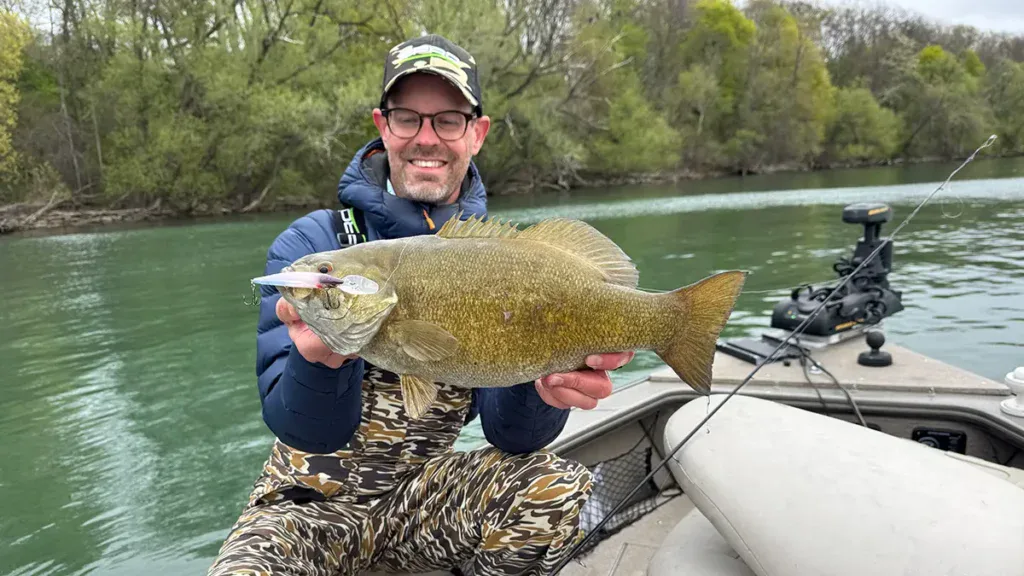
If you want a destination that offers giant smallmouths, world-class trout and salmon, and unbeatable walleye action — all in one trip — the Niagara region belongs at the top of your list. With breathtaking scenery, diverse fish populations, and year-round opportunity, the Niagara stands as one of the premier freshwater fisheries in North America.
Pack your gear. Pick your season. Bring a cooler. Niagara is the real deal.
